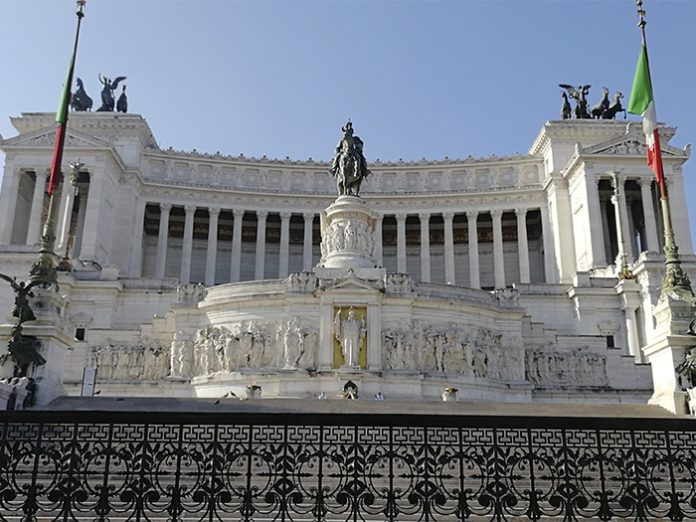The Vittoriano was built at the turn of the 20th Century to honour Italy’s first king, Vittorio Emanuele II, and has since become a must-see for anyone visiting the Eternal City. Prior to the pandemic, Galleria Sacconi (which is located inside the Vittoriano) was chosen to host a temporary exhibition – named Lessico Italiano – composed by 19 different installations designed to celebrate Italian values.
Once the planning was complete, the exhibition’s creator and producer, Palzom Films, contacted Italian audio specialist, AudioFactory, to assist integrator AMP di Fabrizio Dovidio with the installation of a sound system that could live up to the expectations of such an important exhibition.
“The head of audio of Palzom Films, Alessandro Di Maio asked us an audio sound system with three main characteristics,” explained Oreste Parmentola, AudioFactory’s CEO. “It needed to be visually discreet, have high sound quality, and have the capability to be remote controlled. We were encouraged to design a state-of-the-art system using our own products. To do this, we chose to use our DESIGN product line, which has been conceived with this kind of venue and audio requirement in mind.”
As well as the quality of AudioFactory’s own speakers, Parmentola cited power amplifiers with built-in DSP as being key to answering the Vittoriano’s brief.
“Furthermore, using DANTE audio streaming flux through the network was a substantial improvement in terms of reduce complexity of wiring and increase audio quality and reliability,” he said.
The system was comprised of a number of AudioFactory’s DESIGN loudspeakers, including the D04 full-range 4-inch loudspeaker; the D06 full-range 6-inch loudspeaker with driver and differential horn; the D06 full-range 6-inch loudspeaker with driver and high directivity horn; and the DS10 10-inch subwoofer. This was driven by 2 Powersoft Ottocanali DSP + Dante, 5 Quattrocanali DSP + Dante, and 2 Duecanali DSP + Dante.
“We needed a lot of channels distribute along the exhibition, with five positions hidden from the visitors’ view,” said Alessandro Giuliani, AudioFactory’s R&D engineer “The Powersoft products were perfect to cover all the requirements of the project: high quality sound, low fan noise, adequate sound power, and overall remote control.”
Although sound power wasn’t the main challenge for this installation, the Powersoft amplifier platforms’ high voltage rail and low impedance driving capability were key to withstanding the 16-ohm D04 loudspeakers, which were used one per channel or in parallel (up to six per channel) according to the installation requirements.
“After the mounting phase we really appreciated setting up the system through the use of Powersoft’s ArmonìaPlus software, which allows us to tune the system smartly and quickly while walking through the exhibition path in the company of the composer and director,” explained Giuliani. “Dividing the exhibition in areas with ArmonìaPlus groups meant we could easily apply a custom EQ and level setup for each zone.”
Although the layout of the exhibition created some constrains in terms of physical space, the team were tasked with covering 20 different zones with 20 different sound sources distributed along the exhibition path. The main challenge was to choose and place the loudspeakers in order to make the right sound in terms of frequency response, without interferences between adjacent areas.
“Luckily, we were able to work with a professional in-house sound engineer who understood the real problems of this kind of installation,” said Parmentola. “He was also able to act as a bridge with the production help us reach the final result.”
Given how the exhibition area is characterised by large spaces with several zones at different heights, the main obstacles for the installation team were the reverberation and sound bleed between adjacent zones, which could compromise the intelligibility of the audio content.
“We decided that a large number of loudspeakers – positioned as close as possible to the visitors’ path – was the best way to ensure that we could compensate for these issues,” said Giuliani. “We also had to accommodate the fact that different sources would be required to play different sounds at the same time. The ArmonìaPlus software was integral to programme this efficiently and quickly.”
The team also developed software to give in-house operators the ability to switch the system on and off by sending messages through the local network.
“The Powersoft team gave us all the information we were looking for to develop the third-party software needed to accomplish this task,” Parmentola said. “Since then, the production has congratulated the entire team on their rapid action in installing the equipment and setting it up to meet all the initial objectives in such a short period of time. This was also beneficial to the other departments (structural, video, lighting, security and so on), allowing everyone to work to the best of their abilities on this complex exhibition.”





